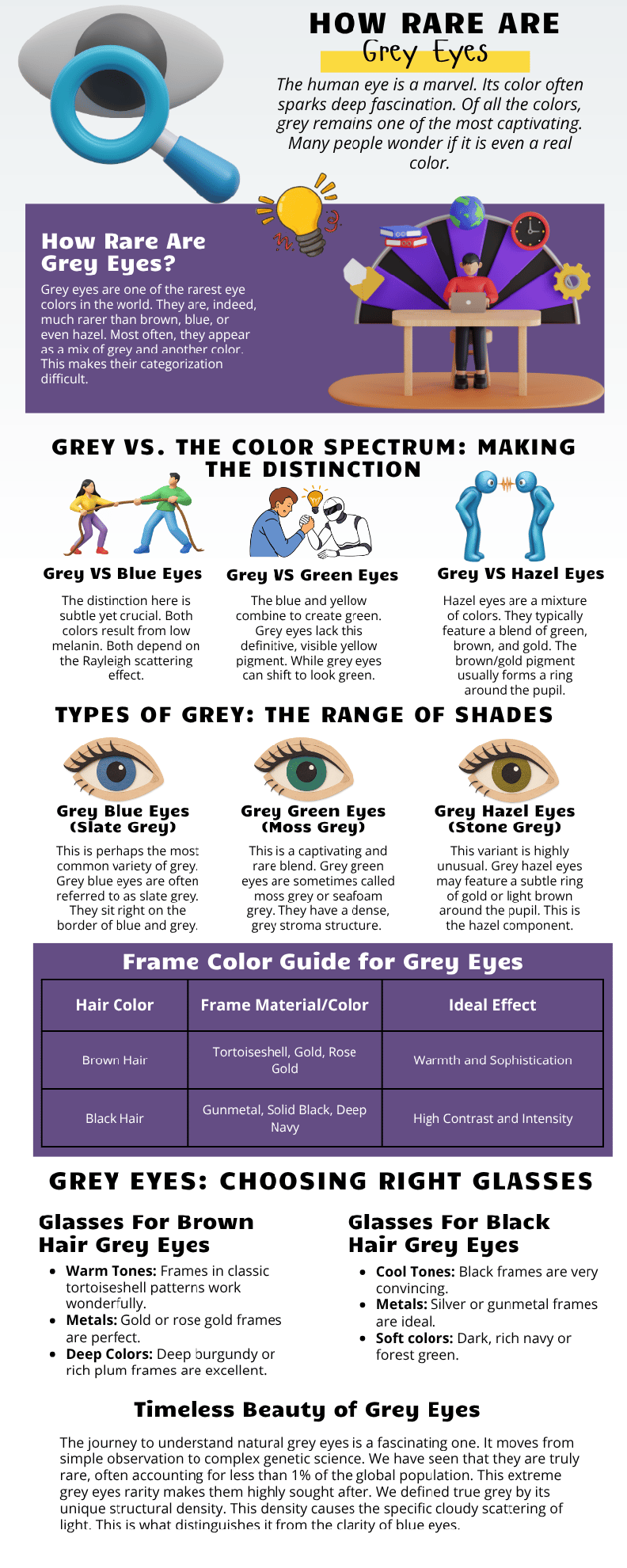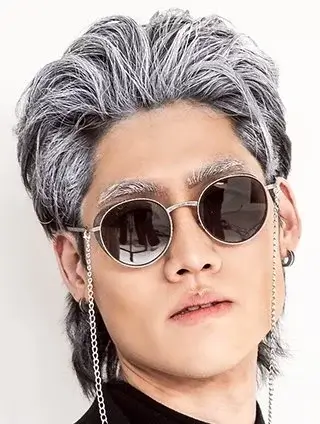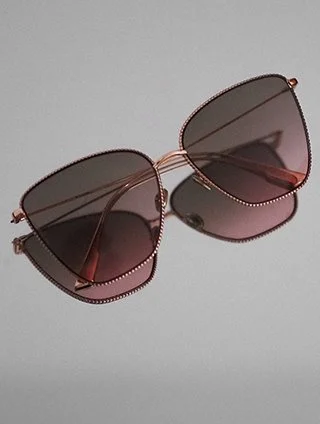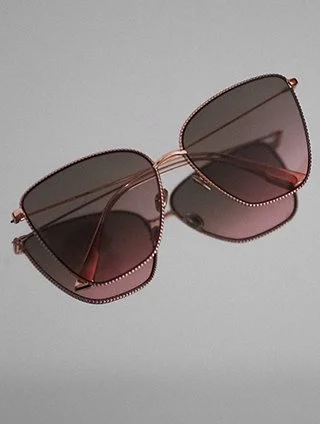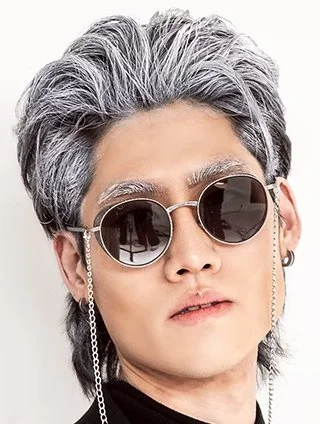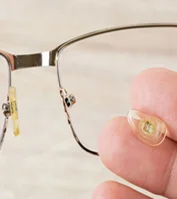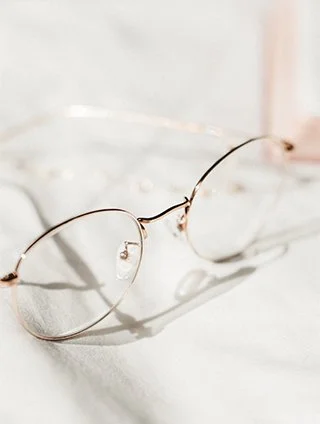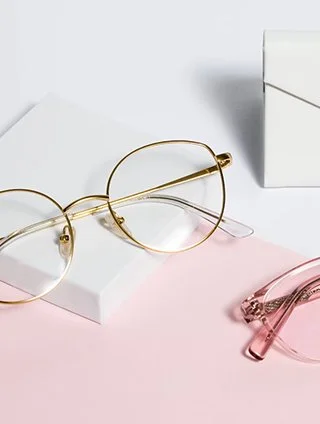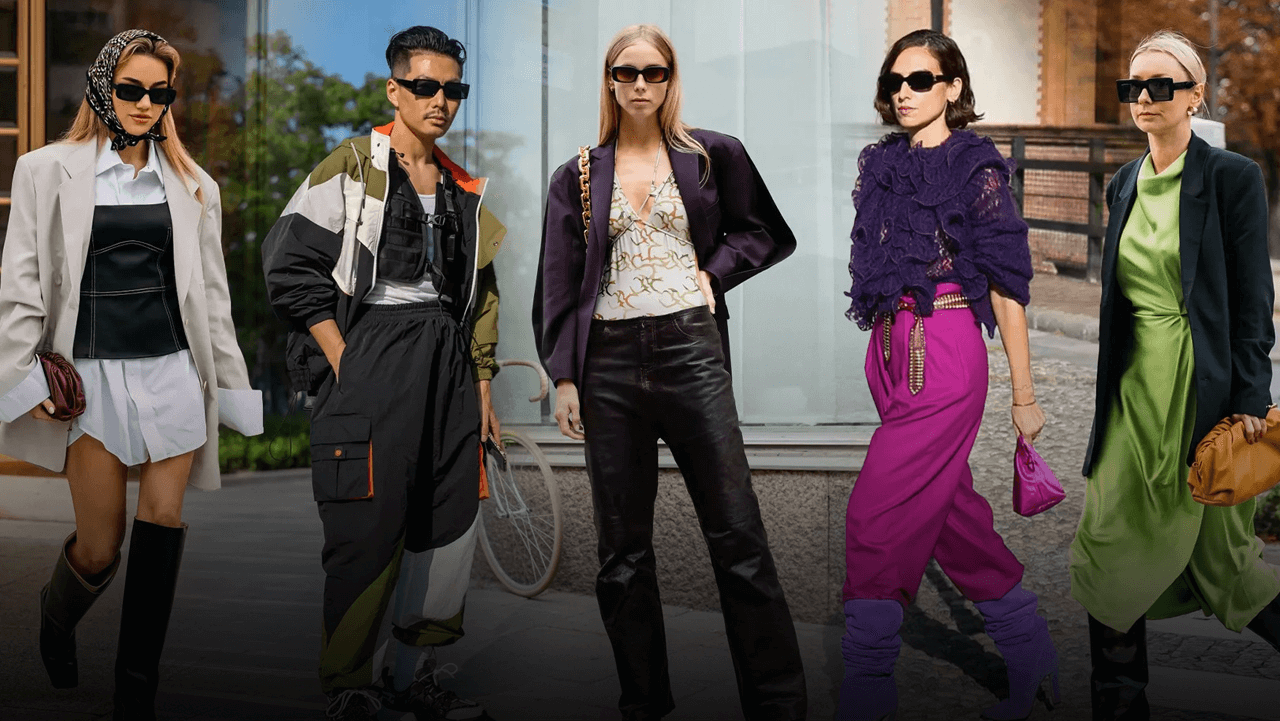Last updated: Tuesday, November 11, 2025
The human eye is a marvel. Its color often sparks deep fascination. Of all the colors, grey remains one of the most captivating. Many people wonder if it is even a real color. Natural grey eyes absolutely exist, and they are not just a trick of the light. These eyes are a true and distinct eye color phenotype. They are not merely a shade of blue but possess unique structural properties.
These properties give them their signature appearance. It is possible to have grey eyes. It depends on a specific combination of genetics. This combination affects pigment levels and iris structure. It is a rare occurrence. However, people are born with grey eyes every day.
Grey eyes look smoky. They may have a metallic look, such as slate or silver. Their ability to change color is their most well-known feature. They often shift between blue, green, and a true grey. This happens depending on lighting, clothing, or mood, and this "chameleon effect" makes them incredibly striking.
The grey eyes cause is simply light physics. It is called Rayleigh scattering. This is the same principle that makes the sky look blue. The iris of a grey eye contains very little melanin. Melanin is a brown pigment. Since the pigment is minimal, the light is scattered back out. However, the grey eyes contain a slightly denser, cloudier stroma (the outer section of the iris) compared to blue eyes.
This density diffuses the light more saturatedly. This makes the eye look grey instead of bright blue. Natural grey eyes scatter light more uniformly across the whole visible spectrum. This gives them that characteristic neutral, cool, and often flat appearance. This optical effect solidifies grey eyes as a special and mesmerizing phenotype.
How Rare Are Grey Eyes?
The main question is about their frequency. How often do we actually see this unique color? The truth is, grey eyes are exceedingly uncommon. This rarity is part of their appeal.
Grey eyes are one of the rarest eye colors in the world. They are, indeed, much rarer than brown, blue, or even hazel. Most often, they appear as a mix of grey and another color. This makes their categorization difficult. This high degree of grey eye rarity is what grants them their unique status.
How Common are Grey Eyes?
They are not common at all. In most statistical studies, they are often grouped with blue or intermediate eyes. This blending skews the numbers. However, when defined purely, their frequency is extremely low. They are less common than green eyes; they comprise approximately 2% of the global population.
To truly explore all the unusual and rare shades, visit our detailed post, "What Eye Color Is The Rarest". It explores such colors as amber, violet, and true green. It provides great context for understanding grey eyes rarity.
Regarding percentages, there is no single definitive worldwide statistic. This is because classification methods vary so much. However, less than one percent of people worldwide have pure grey eyes, according to a number of studies and demographic estimates. This is a very small number.
How Many People in the World Have Grey Eyes?
When we approximate the world population to be about 8 billion people, it cannot be less than 180 million people, which is less than 1%. That is the upper estimate. The number of people with truly pure grey eyes is likely much smaller. They are concentrated mainly in Northern and Eastern Europe.
This makes them geographically rare as well. This highlights just how significant the grey eyes rarity really is. It truly puts them in an exclusive category globally. The structural components required for this shade are highly specific. This specific requirement explains the low proportion. It is proof of the diverse outcomes of human genetics.
Grey VS. The Color Spectrum: Making the Distinction
The most challenging aspect of grey eyes is distinguishing them from other light colors. They are frequently confused with blue and green. However, the scientific and visual differences are quite clear. A subtle, cool tone defines true grey.
True natural grey eyes have a unique light-scattering property. They possess a dense, opaque layer in the iris stroma. This layer prevents the light from scattering purely blue. Instead, it creates a cloudier, flatter, or metallic appearance. This differs from the clear, crystalline look of blue eyes. The color is commonly referred to as slate, silver, or steel. It is not, like hazel, warm; or like yellow, green.
Grey VS Blue Eyes
The distinction here is subtle yet crucial. Both colors result from low melanin. Both depend on the Rayleigh scattering effect. The difference lies in the stroma's collagen density. Blue eyes have a lower density. This allows shorter blue wavelengths to reflect out clearly, which gives them a vivid, bright blue hue. Grey eyes have a significantly higher collagen density. This acts as a filter. It scatters the light more broadly. This results in the characteristic cloudy or smoky metallic grey. Grey eyes rarely have the intense brightness of a pure blue eye.

Grey VS Green Eyes
Green eyes are fundamentally different because they require two things. They need low melanin and also need a small amount of yellow-brown pigment, called lipochrome. This pigment mixes with the scattered blue light. The blue and yellow combine to create green. Grey eyes lack this definitive, visible yellow pigment. While grey eyes can shift to look green (especially when the person wears green clothing), the eye itself remains cool-toned. It will never have the intrinsic warmth that the yellow pigment gives to green eyes. This makes the visual difference clear upon close inspection.
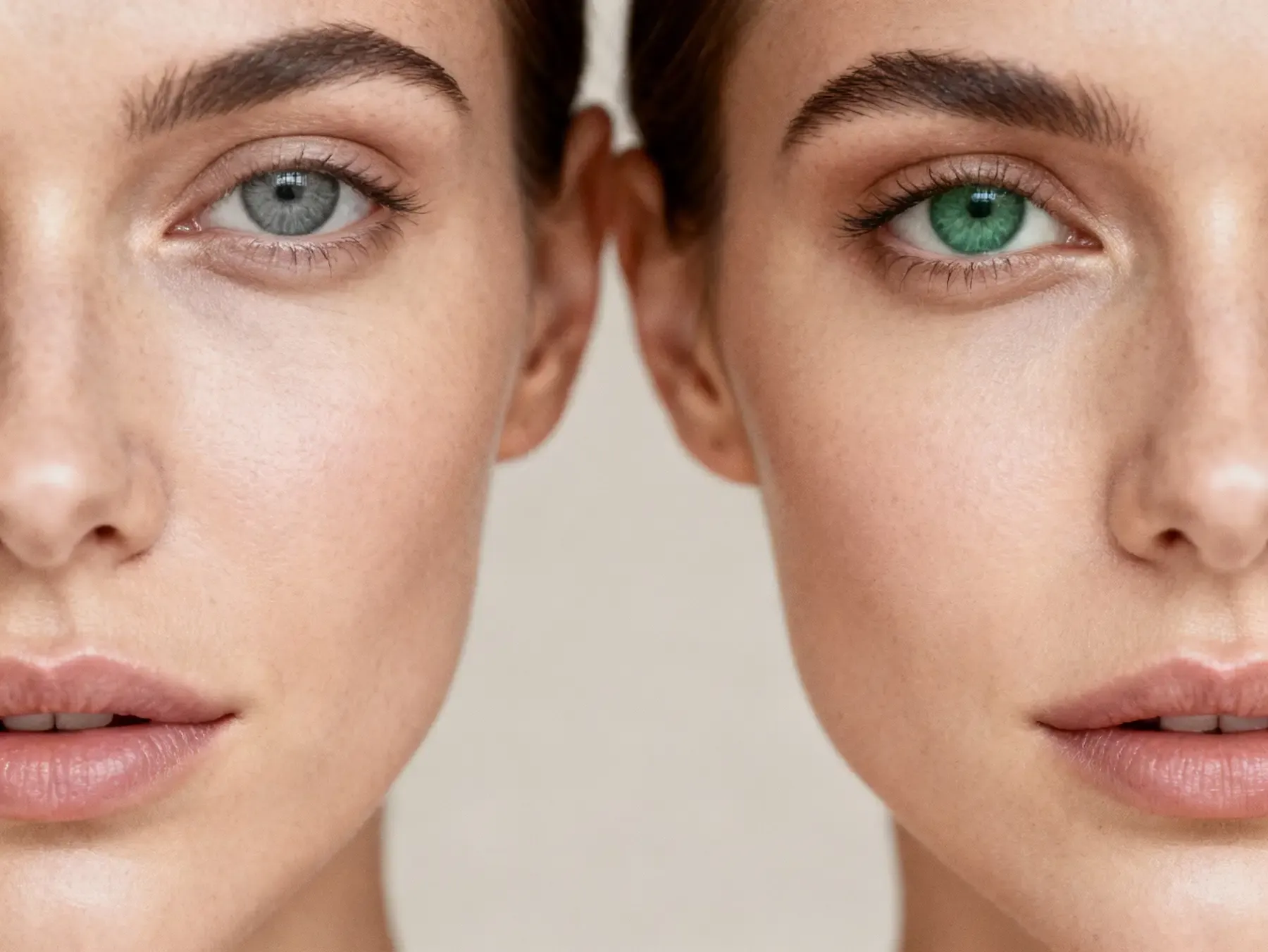
Grey vs Hazel Eyes
Hazel eyes are a mixture of colors. They typically feature a blend of green, brown, and gold. The brown/gold pigment usually forms a ring around the pupil. A greenish or yellowish outer ring surrounds this. Hazel eyes are warm. Grey eyes, conversely, are fundamentally cool. The iris of a true grey eye will be a consistent, slate-like hue. It might change, but the distinctive multicolored zones that define hazel eyes won't be present. This lack of multi-tonal pigment partially defined the grey eyes rarity.
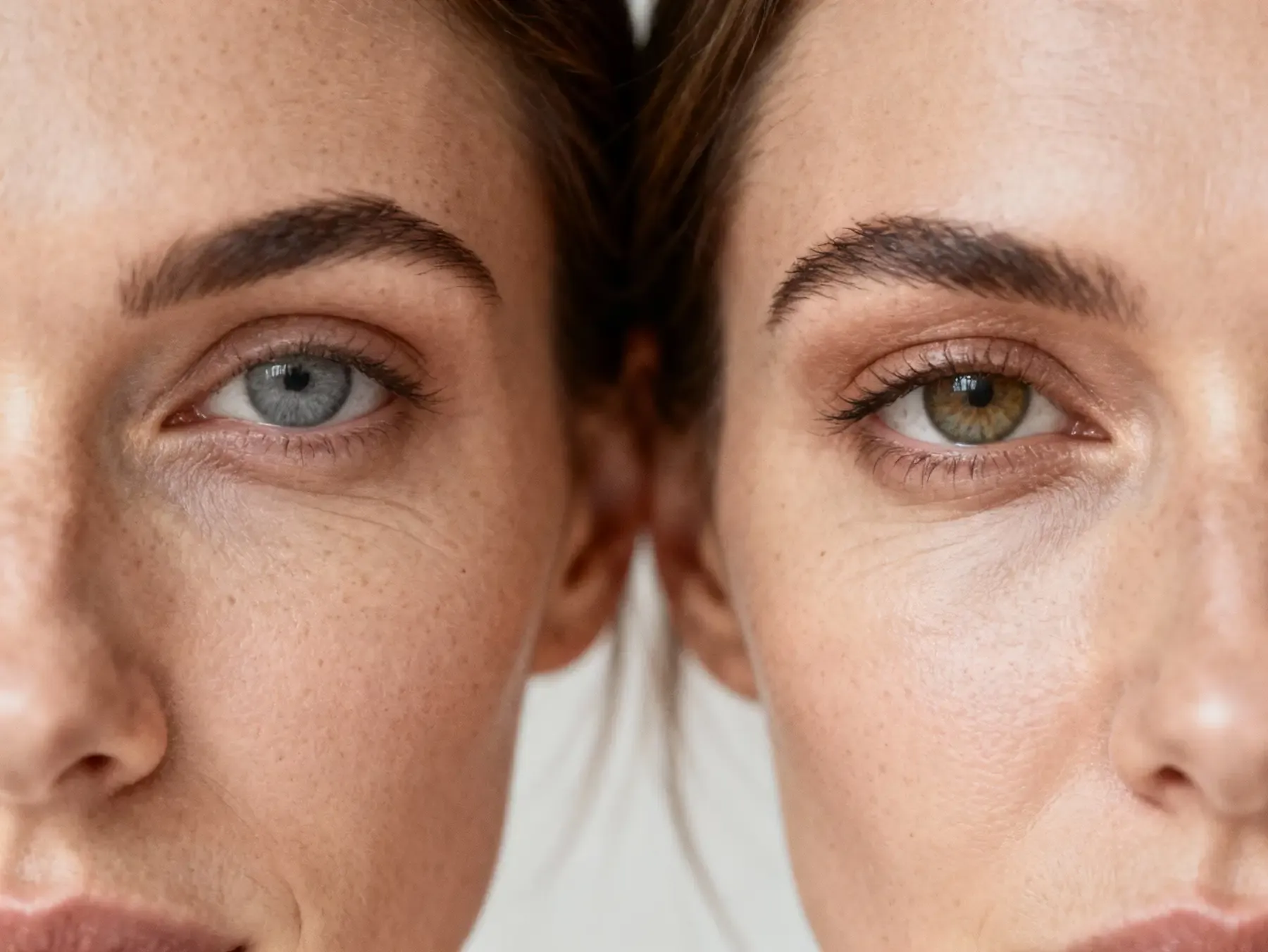
Types of Grey: The Range of Shades
While the search for a "pure" grey eye is fascinating, most natural grey eyes exist on a spectrum. They blend subtly with their neighboring colors. These variations, or subcategories, are what most people encounter. They demonstrate the complexity of eye color genetics.
There are three main variants of grey eyes. These variants depend on the precise amount of structural density and trace pigments. These slight variations determine whether the eye favors blue, green, or even hazel tones. All types maintain the cool, smoky base color. They all share the same low melanin level.
Grey Blue Eyes (Slate Grey)
This is perhaps the most common variety of grey. Grey blue eyes are often referred to as slate grey. They sit right on the border of blue and grey. These possess slightly less stroma density than pure grey eyes. This allows a clearer reflection of the blue spectrum. As a result, they appear blue in bright light. They go back to a distinct slate or steel grey indoors.
The blue component gives them a striking depth. They are beautiful and common examples of the scattering phenomenon. They show how closely linked the two light colors are genetically. This specific shade is common in Scandinavian and Baltic regions. If you are interested in the wider category, you should read our article, "How Rare Are Blue Eyes".
Grey Green Eyes (Moss Grey)
This is a captivating and rare blend. Grey green eyes are sometimes called moss grey or seafoam grey. They have a dense, grey stroma structure. But they also possess a microscopic amount of yellow lipochrome pigment. This small hint of yellow mixes with the underlying scattered blue light. The resulting color is a subtle, muted green-grey. The green is never vibrant, unlike a pure green eye.
Instead, it is earthy and soft. This makes the eye look complex and mysterious. The green tint usually appears towards the outer edge of the iris. It is a beautiful example of minimum pigmentation working together to the utmost effect. You can discover more about the second rarest colour in the world in our blog, "How Rare Are Green Eyes?"
Grey Hazel Eyes (Stone Grey)
This variant is highly unusual. Grey hazel eyes may feature a subtle ring of gold or light brown around the pupil. This is the hazel component. However, the majority of the iris remains a cool, opaque grey. This shade is often referred to as stone grey. It differs from true hazel. In true hazel eyes, the brown and green areas are dominant and clearly defined. In stone grey eyes, the grey remains the dominant hue.
The central ring of warm color is very thin and subdued. This creates a beautiful contrast between warm and cool tones. It is one of the most genetically complex variations. Hazel color represents a precise balance between scattering and small pigment deposits. This blend shows that even the rarest color can have sub-rarities. For comparison, see our article, "How Rare Are Hazel Eyes?"
Grey Brown Eyes
The term grey brown eyes is often a misconception. It is scientifically challenging. Pure grey eyes are defined by the lack of significant brown pigment (melanin). Eyes that appear mostly brown with grey elements are usually classified as a type of hazel. Or they are light brown eyes that change shade in dim light.
However, if a person exhibits a dense grey outer ring surrounding a darker brown inner ring, they might use this term. This is an extremely rare presentation. It represents a phenomenon called heterochromia or a unique pigment distribution. True grey is a cool color; true brown is a warm color. They rarely blend uniformly. This is why grey eyes rarity is often tied to the purity of the grey shade.
Type of Grey Eye | Common Descriptor | Key Visual Difference | Genetic Trait |
Grey blue eyes | Slate Grey | Appears more blue in bright light, metallic indoors. | High stroma density, almost no pigment. |
Grey green eyes | Moss Grey | Subtle, earthy green tint towards the edge. | High stroma density + trace amounts of yellow lipochrome. |
Grey hazel eyes | Stone Grey | Thin ring of light brown/gold near the pupil. | Localized central melanin production, grey in the outer iris. |
Grey brown eyes | Dark Grey | Uniformly dark grey/brown appearance. | Extremely rare; high stroma density with dark melanin dispersed only in the inner layer. |
How Many People Have Grey Eyes? Demographics and Destiny
Understanding the distribution of grey eyes helps confirm their scarce nature. The geography of light eyes is distinct. The vast majority of people with grey eyes have European ancestry. This is due to the genetic mutations that cause low melanin production. These mutations originated in the Northern parts of Europe. Today, the most common grey eyes are in the Baltic Sea region. If you have any other eye color but still do not know which glasses suit you well, then read this blog to know which glasses best match your eye color.
Other countries, such as Finland, Estonia, and Latvia, have greater concentrations. This geographical clustering proves the concrete evolutionary force that made this characteristic survive. The grey eye mutation is a further refinement of the blue eye gene. It represents a different structural outcome from the same genetic starting point.
People With Grey Eyes
While we showed that the global prevalence is less than 1%, the regional numbers are higher. In some concentrated areas, the percentage of grey-eyed individuals can reach single digits. A small isolated community may be an example of a high rate. This is a significant difference from the rest of the world, where brown eyes are dominant. The concentration of natural grey eyes is a genetic echo of ancient populations.
Black People With Grey Eyes
The appearance of grey eyes in people of African or Asian descent is particularly striking. These are often true examples of grey eyes rarity. This phenomenon occurs due to the same genetic mutation. This phenomenon can emerge in any population. It is not exclusively tied to European descent. The key is the specific variation that limits melanin production.
When light eyes appear on a person with dark hair and dark skin, the contrast is at its maximum. This creates a powerful and often stunning visual effect. These individuals are a beautiful example of human genetic diversity. Their eye color frequently generates curiosity because it defies common expectations based on skin pigmentation.
Famous People With Grey Eyes
Grey eyes have captivated artists and audiences for centuries. Many famous figures possess this rare trait. Their eyes often appear mysterious and intense on camera. These people with grey eyes include actors and musicians. Their striking gaze is often a signature part of their look.
- Cate Blanchett: Her cool, changing eye color frequently shifts between blue and grey, showing the chameleon effect.
- Paul Newman: While often labeled blue, his eyes had the metallic, slate quality characteristic of grey.
- David Bowie: His famous eyes, one naturally blue and the other damaged, often appeared grey, adding to his mystique.
These examples solidify the cultural importance of the color. It is a shade often associated with depth, wisdom, and reserved power in media. The perception of grey eyes rarity enhances their on-screen allure. They are often used to signify a strong, complex character.
Styling Grey Eyes: Choosing the Right Glasses
The chameleon nature of natural grey eyes makes choosing complementary accessories fun. The right eyeglass frame can either enhance the cool grey tone or pull out the latent blue or green undertones. The neutrality of grey eyes means they pair well with both warm and cool colors. The frame color you select is a powerful tool. Choosing the perfect frame is a challenge in color theory.
Glasses For Brown Hair Grey Eyes
Brown hair provides a natural warmth that contrasts beautifully with cool grey eyes. The goal is to choose a frame that bridges this gap. You want to harmonize the warm and cool tones.
- Warm Tones: Frames in classic tortoiseshell patterns work wonderfully. The amber and honey flecks in the tortoiseshell pull out any subtle warmth in the iris. This can sometimes make the eyes appear more like grey hazel eyes.
- Metals: Gold or rose gold frames are perfect. These warm metals provide a sophisticated, elegant contrast. They prevent the grey eyes from looking too washed out or stark.
- Deep Colors: Deep burgundy or rich plum frames are excellent. They offer depth without being harsh. They provide a mature, polished look.
Glasses For Black Hair Grey Eyes
Black hair is the ultimate cool color. It creates a stark, dramatic contrast with natural grey eyes. The frame should complement this high-contrast look. It is all about leaning into the coolness of the grey of the steel.
- Cool Tones: Black frames are very convincing. They mirror the hair color and make the grey eyes pop with intensity. This highlights the grey eyes rarity by making them the focal point.
- Metals: Silver or gunmetal frames are ideal. These cold, metal tones are just right with the gray eye. This underlines the silvery quality of the grey.
- Soft colors: Dark, rich navy or forest green. These are cool colours, but they create a touch of surprise colour. The Navy hue can amplify the blue color of individuals having grey blue eyes.
Glasses For Red Hair Grey Eyes
The most dramatic contrast is red hair. The brightness of the hair is a beautiful contrast to the coolness of the grey eyes. And the best frame should control this strong color combination.
- Frame contrast: Deep forest green or emerald frames. Green is the opposite of red. This makes it a dynamic and attractive mix. This option will enhance the faint shade of green in those with grey green eyes.
- Earthy Tones: Bronze metals or copper. These metal frames are as warm as red hair. However, they are delicate enough that they do not overpower the grey. The frame should complement this high-contrast look. It is all about depending on the coolness of the steel grey.
- Cool Tones: Black frames are very convincing. They add a refined element.
- Neutral Depth: Clear, thick acetate frames. This choice allows the hair and eye color to take center stage. The clear frame acts as a modern, clean boundary.
Regardless of your hair color, the perfect pair of glasses can elevate the unique beauty of your natural grey eyes. They deserve frames that match their mystique and grey eyes rarity. We talked above about limited hair color. Here is a brief version of what pair of glasses best matches your hair color.
Frame Color Guide for Grey Eyes
Hair Color | Frame Material/Color | Ideal Effect |
Brown Hair | Tortoiseshell, Gold, Rose Gold | Warmth and Sophistication |
Black Hair | Gunmetal, Solid Black, Deep Navy | High Contrast and Intensity |
Red Hair | Emerald Green, Bronze, Copper | Vibrant Contrast Amplifies Green Tints |
Eyeweb offers a variety of premium eyeglasses and sunglasses that suit many eye colors and hairstyles. Choose the most appropriate eyewear colour and style to embrace your individuality. We are here to assist you in finding the right frame.
Timeless Beauty of Grey Eyes
The journey to understand natural grey eyes is a fascinating one. It moves from simple observation to complex genetic science. We have seen that they are truly rare, often accounting for less than 1% of the global population. This extreme grey eyes rarity makes them highly sought after. We defined true grey by its unique structural density. This density causes the specific cloudy scattering of light. This is what distinguishes it from the clarity of blue eyes.
Whether you possess striking grey blue eyes or the subtle blend of grey green eyes, your eye color is special. If you have the complex, patterned look of grey hazel eyes or the extremely rare grey brown eyes structure, you carry a beautiful genetic trait. This color shifts and changes, reflecting the environment and the surrounding light. It remains a symbol of intensity and allure across cultures.
It confirms that the human eye is not just an organ of sight, but a living canvas of light and density. The grey eyes rarity makes them valuable. But their ever-changing nature makes them truly priceless.
